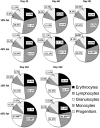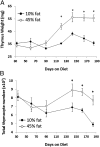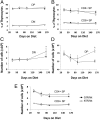Enhancement of hematopoiesis and lymphopoiesis in diet-induced obese mice
- PMID: 22538809
- PMCID: PMC3356670
- DOI: 10.1073/pnas.1205129109
Enhancement of hematopoiesis and lymphopoiesis in diet-induced obese mice
Abstract
A rodent model of diet-induced obesity revealed that obesity significantly altered hematopoietic and lymphopoietic functions in the bone marrow and thymus. C57BL/6 mice were fed a mixed high-fat diet (HFD) of 45% fat or 10% fat diet (lean controls) for 180 d. A sustained increase in the numbers of cells found in bone marrow and thymus of HFD mice occurred from day 90 to day 180. However, with the exception of a 10-18% increase in the proportion of lymphocytes, the composition of monocytes, granulocytes, erythrocytes, and mixed progenitor lineages remained normal in the marrow. Likewise, thymuses of HFD mice increased 30-50% in size compared with controls, with analogous increases in thymocyte numbers. The overall thymus cellular composition remained normal. Although increased blood and lymphatic volume in obese mice would play a role in increased hematopoiesis, there were large and disproportionate increases in blood leukocytes of HFD mice, indicating that homeostasis was not maintained. Leptin, which promotes lymphopoiesis and myelopoiesis, reached 100 ng/mL in sera from HFD mice. Moreover, a three- to sixfold increase in adipocytes in marrow resulted in spiked leptin mRNA expression in bones of HFD mice compared with lean controls. Other cytokines and growth factors did not show any increases in obese marrow. The substantial increase in lymphopoietic and hematopoietic processes in HFD mice indicates that the primary tissues are another facet of the immune system dysregulated by obesity, which was perhaps fostered by higher amounts of leptin in marrow and serum.
Conflict of interest statement
The authors declare no conflict of interest.
Figures








References
-
- Hardy RR, et al. B-cell commitment, development and selection. Immunol Rev. 2000;175:23–32. - PubMed
-
- Rolink AG, Schaniel C, Andersson J, Melchers F. Selection events operating at various stages in B cell development. Curr Opin Immunol. 2001;13:202–207. - PubMed
-
- Fraker PJ, King LE. Reprogramming of the immune system during zinc deficiency. Annu Rev Nutr. 2004;24:277–298. - PubMed
Publication types
MeSH terms
Substances
LinkOut - more resources
Full Text Sources
Other Literature Sources
Medical

